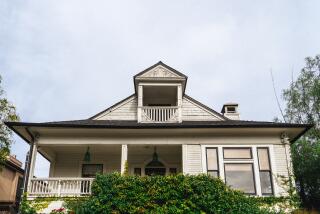A Monument To Gentility
- Share via
WHITE SULPHUR SPRINGS, W. Va. — In 1838, a British visitor declared the resort here proof of America’s royal aspirations, whatever ideals the new nation espoused. “No one is allowed accommodation at these springs who is not known,” he wrote. “It is at this place that you feel how excessively aristocratic and exclusive the Americans would be.”
Paintings of the scene by the “curative” sulfur waters showed men in top hats and long coats and women--”celebrated belles,” the Britisher termed them--in hoop skirts and parasols.
After the Civil War, as Robert E. Lee summered in one of the cottages, the Chesapeake and Ohio Railway built a spur right to the entrance of the Old White Hotel--and the place really took off. Up until World War II, guests at the resort--by then called the Greenbrier--formed a long line through the lobby each evening so they could be announced at dinner.
For two centuries, then, this has been one of the bastions of American gentility, to the degree that’s not a contradiction in terms. Today, gentility seems like an antiquated notion, but it intrigues us still because it suggests some refuge from the rudeness all around. Yet this gentility business also makes us uneasy, what with conjuring up not only a spirit of exclusivity but also of exclusion, snobbery, pretense--not to mention a steep bill.
So my friend Heidi and I set out, both curious and wary, for a visit last July to one of the most renowned traditional resorts in the country, a place that’s hosted 26 presidents and promises tastes of another era but is also, we heard, undergoing changes.
To go with the 6,500 acres of equestrian trails and trout streams and shooting ranges and those signs reminding you to be quiet at night (“It’s Sleepy Time Down South”), the Greenbrier has opened a golf school, as if it wasn’t enough to sample the three courses that have drawn serious players for decades. It’s also offering tours of its long-secret “Government Relocation Center,” a.k.a. the Bunker, the fallout shelter kept ready for Congress through the Cold War. And what’s this about a casino?
We were intent on experiencing both the old and the new as we pulled up to the Georgian-style hotel so big it almost out-White Houses the White House. But I also found my roots betraying me. As someone from more peasant than planter stock and tracing my ancestry back just two generations--to Grandpa Harry--I couldn’t help but worry: Will they soak me for the valet parking?
The Greenbrier was rated the top resort in North America last year by readers of Conde Nast Traveler magazine. Subscribers to Golf Digest gave it such high marks for service that the magazine had a staffer try to sabotage a visit, showing up late for tee times and leaving his shoes under the bed. No luck. The shoes were waiting, with a kind note, when he got home.
I too was on the lookout for the catch. Thus my reaction when the bellman gave a “welcome” and asked whether we’d like someone to park the car. I was not so crass as to inquire, but it nagged me, whether I’d just spent $25 more per day on top of . . . well, high-season rates for a standard room for two start at $486 a night (though that includes breakfast and dinner). We were at $590 because one of us--me--was on a golf package.
At least this isn’t one of those packages in which the fine print covers only 18 holes a day, carts extra. “Play all you want,” the reservation woman said, and I tested that by getting a tee time that was hours before check-in. No problem, the bellman said--my golf bag would be at the clubhouse in minutes.
One of the first things you see in the lobby is a Gilbert Stuart portrait of a gentleman, though not one of his George Washingtons. The Washington, on another wall, is by Jane Stuart, his daughter.
Down a floor we ran into a legend in the flesh--Sam Snead, who got his first golf pro job here in 1936. He was signing merchandise in the Sam Snead Collection shop, as dapper as ever, nearing 90.
Along a corridor is a display of Gold Service china used for a 1956 dinner by the president of C&O; Railroad, now CSX Corp., which has owned the Greenbrier for most of the century, except when the government used it during World War II as a military hospital and as housing for high-level Japanese and German POWs. Their forced labor? Maintaining the golf grounds.
A shuttle bus took us from the white-columned back entrance past Paradise Row (cottages built in the early 1800s) to the clubhouse. My clubs were already on the cart I would share with another player--the visit’s first surprise.
Tommy Jones hardly fit the mold of the powdered-wig set. He was 65ish and potbellied, had a shirttail hanging out and spoke in a country twang. He was from down the road in Huntington, W. Va., “retired railroad.” What did he do for the railroad? “Engineer.” A conductor.
OK, he’s not your average choo-choo driver. He’s a Democratic activist who throws power breakfasts (“invited Al Gore to one”).
We were on the Greenbrier Course, which was redesigned by Jack Nicklaus for the 1979 Ryder Cup match. It features an extraordinary variety of holes: a par-4 curling around water followed, say, by a par-5 up a hill, into woods.
While we played, Jones filled me in on the Greenbrier’s bid to turn an exhibit hall into a casino. The Greenbrier County Commission this month is deliberating whether to schedule a referendum on allowing gambling to bolster business in the winter when--unlike overflowing summer weekends--many of the 637 rooms are empty. The plan has encountered opposition here in the Bible Belt and among some regulars.
As I got his analysis (“My friend the attorney general says . . .”), a rain squall sent us scampering for shelter.
When the sun returned, we watched two baby deer bounce through the woods. By the time I reached the 18th hole’s huge, St. Andrews-style “double green,” I was ready for more.
The starter said “No problem,” clear sailing on the Meadows, the easiest of the courses. Heidi joined me to report on her first sampling of the Greenbrier’s rich buffet of activities: falconry.
Five guests met a professional handler for an hourlong introduction ($65) to the 25 majestic falcons, hawks and owls that live on-site. When released, one flew gracefully to a dead tree, then swooped to grab a piece of raw chicken the handler tossed in the air. “Falconry started as a sport of necessity, to get food,” he explained, “then became the sport of kings.”
Though the sport is 4,000 years old, the Greenbrier introduced it only in 1994--a new way to embrace the old, and another culture’s concept of gentility.
The practice of lining up to be announced at dinner ended after WWII, when New York decorator Dorothy Draper redid the hotel. She divided the endless lobby, the lineup route, into a string of spaces done in bright colors, flowered prints and chandeliers.
Our recently updated room was nevertheless Draper traditional: cherrywood furniture, including a large armoire (holding an entertainment center) and sunshine yellow wallpaper, bedspread and drapes. On the sitting area table we found a welcoming fruit basket.
A violin-piano duo was playing Mozart’s “A Little Night Music” as we perused the dining areas, all packed. It was Fourth of July weekend, and we couldn’t get over the extended families, 10 or 20 at a table, and how well behaved the kids were, little boys enduring their ties and girls their hair bows.
The Greenbrier makes a fuss over food. One chef was swiped by the Clintons in Washington. There are daily cooking demonstrations (free) and 3 1/2-hour classes ($110 per person, lunch included). For breakfast you can get trout with your eggs, or smoked trout hash. Dinner one night featured an appetizer of marinated mushrooms with Watsonville artichokes, and sauteed brook trout with lemon butter sauce, a country-style grit cake and tomato and leek ragout.
The high-ceilinged Main Dining Room was a trip--all those portraits!--and its food well beyond simple mountain fare. It was not exciting, though--not the sublime offerings you find, say, in one of those Napa Valley inns that exist for the food and drink and don’t have to feed 1,000. If I could do it again, I’d try the premium Tavern Room, overcoming my old peasant’s antipathy to the surcharge--$40 extra per person--to taste its pheasant soup and Beluga caviar.
After peach cobbler and coffee, we strolled through the lobby (where concerts are offered at tea time) and the small room for writing letters--letters!--and past the indoor pool pavilion, Hearst Castle ornate. The bowling alley was filling with families and a video game room with teens, playing hip-hop on a jukebox, even here.
In the Old White Club lounge, two teenage boys were in tuxedos, smoking cigars--in full view of a parent--while a pair of debutante-ready girls paraded by. Also in the bar: black guests. It was comforting to see this at one of the symbols of the plantation South.
The next morning I played the Old White course, one of the most enjoyable anywhere. Designed in 1913 by Charles Blair MacDonald, it has its first tee on a hilltop, mountains looming in front of you. Time and again it’s like that, exhilarating tee shots that set the target perfectly visible, leaving few of the absurd blind shots common on modern courses.
I was paired with an Ohio couple celebrating their 30th anniversary--he’s in real estate, she’s friends with George Steinbrenner. They had thought of taking their grandkids but worried that they were “too unruly.”
Afterward I met Heidi to tour the fallout shelter. She was brimming with stories from a nature hike (free), the guide explaining not only the flora but also how the trails were used for courtship walks in days when the belles came looking for suitable husbands, and the menfolk to politic. Heidi then hit the spa for the 50-minute “Greenbrier” treatment ($93): a mineral bath, high-pressure spray shower, steam or sauna, and massage. No one claims anymore that the sulfurous waters here cure rheumatism. But one spa package includes a “diagnostic examination” at the Greenbrier Clinic, a medical facility popular with business execs, especially when their companies pay.
The clinic also provided a cover for having doctors around if the Cold War’s worst scenario played out and Congress moved here. Golfing President Dwight D. Eisenhower approved the site for a relocation facility in 1958.
“Project Greek Island” remained secret until 1992, when a writer revealed in the Washington Post that taxpayers were still spending millions to maintain a fallout shelter able to sustain 1,100 dignitaries.
Folks here still are bitter about the ill-mannered disclosure, which made the shelter instantly unusable. It seemed doomed for dismantling until one of its former supervisors suggested that the public might pay for a glimpse into “a time we feared we’d be obliterated by some Communist conspiracy.”
The $25-per-person tours began in December 1996. You go through a 25-ton door built into a hillside, disguised with a phony “Danger High Voltage” sign, and pass decontamination showers, boxes of dehydrated chicken a la king, an imposing power plant, dormitories, TV studio facilities (to send broadcasts to whom?) and a tiny jail with two boxes of straitjackets, if congressmen went bonkers. “Why only two?” deadpanned Mia, our guide.
The tour ends in a public area of the hotel you’d never dream was protected by 5-foot-thick concrete walls--the exhibit hall tabbed to be a casino.
The next morning, we got it. What the place is about.
We were on the first tee of the Greenbrier Course. I was hoping to play 36 holes, and Heidi was tagging along before taking a tour of the hotel and a three-hour clinic at the Sam Snead Golf Academy. We asked the starter which holes would leave us near the clubhouse so that she could walk in.
He said, “Why don’t I send someone out to get you?”
Someone was waiting behind the sixth green, in a cart.
That afternoon, at the half-day golf clinic ($180)--which covers swing basics, chipping and putting--a woman from Georgia, feeling the sun, asked if anyone had some Motrin. There were baskets of painkillers (and sunscreen and bug spray) in the school’s headquarters, but no Motrin. The woman said fine, “anything” would do. But the pro nodded at an apprentice, who disappeared--and came back with Motrin.
There was no flourish about the gesture, no scraping and bowing. It was just the philosophy of Yes. We realized then: You encounter perhaps 200 of the Greenbrier’s 1,600 employees over a stay, and they’re all like that.
Having seen this, we were a bit baffled last January to hear that the Greenbrier had suffered a rare blow to its image: Mobil Travel Guide downgraded it to four stars after 38 years at the rare five. The company said the “legendary property in this ratings period . . . fell a little bit short.” How? There weren’t radios in the rooms, there weren’t three phones in every room, not every TV was in an armoire. That sort of thing.
What’s an old-fashioned place to do? They’re modern enough to know the answer: They’re putting in the phones.
It was time for the bill. I tried to blunt the damage the last morning with a final round on Old White, paired with the Gosnells from suburban Washington. I didn’t begrudge the husband and wife--fine, courteous players--whatever it is they do that enabled them to come here a dozen years in a row, at one point. Their kid, Hunter, was another matter.
He was 11 and 79 pounds and didn’t have golf shoes. He did, however, have an amazing swing. On the off-the-cliff first hole, he sent three shots down the middle, the last on the green. The second hole, he sank a putt for a par. Then he said, “I beat you!”
Not so. By then my game was zoned. I’d birdied. But Hunter’s mom said, “You’re giving him a stroke a hole, aren’t you?”
Perhaps it was ill-mannered to take the bet, like swiping candy from a babe. But I might need help with that valet tab.
I didn’t. Hours later, at checkout, I slowly unfolded our bill--no parking charge. While you’d never call $2,300 for three nights a bargain, it was a deal, I decided, when you consider what a room alone runs at some new luxury hotels. Here you got meals and, in my case, 102 holes. I smiled, I swear, when I paid the kid his winnings.
*
Paul Lieberman writes about culture for The Times’ Calendar section.
(BEGIN TEXT OF INFOBOX / INFOGRAPHIC)
GUIDEBOOK
Going High Class
at the Greenbrier
Getting there: The Greenbrier is a 4 1/2-hour drive southwest of Washington, D.C., just off Interstate 64 in White Sulphur Springs, W. Va. For 130 years there has been a train stop at the hotel’s entrance as well, served now by Amtrak. US Airways flies into Greenbrier Valley Airport in Lewisburg, W. Va., 15 minutes from the hotel, with direct flights from Washington (Ronald Reagan Washington National Airport) and New York, among other cities. Advance-purchase, round-trip fares from LAX begin at $373.
Where to stay: The 6,500-acre resort has 637 guest rooms, including 46 suites and 71 guest and estate houses. Brochure rates start at $486 for two people for a standard room during high season, April 1 to Oct. 31. The historic row cottages begin at $792. From Nov. 1 to March 31 (excluding holidays), standard rooms start at $392. Rates include breakfast and dinner in the Main Dining Room (or the more casual Sam Snead at the Golf Club or Draper’s Cafe). The gourmet Tavern Room costs an extra $40 per person. Children under 18 staying with parents are free, including their meals. A $22-per-person daily service charge takes care of most tipping.
Golf packages begin at $323 per person midweek, $394 on weekends (minimum two-night stay). Without a package, golf costs $145 per 18 holes April through October. The Greenbrier’s Sam Snead Golf Academy offers various clinics; a one-hour class costs $45, half-day clinics cost $180.
For more information: The Greenbrier, 300 W. Main St., White Sulphur Springs, WV 24986; telephone (800) 624-6070 or (304) 536-1110 and (304) 536-7818, fax (304) 536-7834, Internet http//:www.greenbrier.com.
More to Read
Sign up for The Wild
We’ll help you find the best places to hike, bike and run, as well as the perfect silent spots for meditation and yoga.
You may occasionally receive promotional content from the Los Angeles Times.






